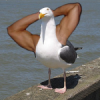On the left is what I get in Direct3D9, and on the right is OpenGL

EDIT:
I checked the positions they each recreate and OpenGL's doesn't look like Direct3D 9's, so I looked at the texture offset
I'm using:
float GetRandom(float2 uv){ return tex2D(randomTex, screenSize * uv / 32.0f).x;}float2 Rotate(float2 c, float ang){ const float cosAng = cos(ang); const float sinAng = sin(ang); return float2(cosAng*c.x-sinAng*c.y, sinAng*c.x+cosAng*c.y);}float offset = sampleRadius/max(40.0,p.z);float2 texOffset = Rotate(vec[4], GetRandom(IN.uv)*8.0)*offset;It's not the most recent version, but with the limited testing I did, it seemed to be slightly slower. Regardless, here are my results with Direct3D 9 (which works) and OpenGL (which doesn't)

I'm thinking this has something to do with it, but I'm not sure if this is the root of the problem. Any thoughts?
[Edited by - AgentSnoop on March 27, 2010 7:13:39 PM]








